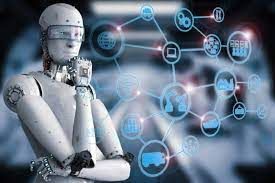
Artificial Intelligence (AI) and Machine Learning
The concept of Artificial Intelligence (AI) & Machine learning (ML) isn’t new. AI is a wide-ranging branch of computer science involved with building smart machines capable of performing tasks that typically require human intelligence. However, ML is an application of AI that gives the ability to devices to learn from their experiences and improve themselves without doing any coding. With the ever-rising volume of data, the organizations are relying on AI and ML models to scale their operations, support staff in working better and faster, uncover hidden insights from data, or even confirm and challenge underlying assumptions.
Why are AI and ML important?
Data is an increasingly important business asset, with the amount of data generated and stored globally growing at an exponential rate. As per Forbes, there are 2.5 quintillion bytes of data created each day at our current pace. Also, there is no use of collecting data if one has nothing to do with it. But, these enormous floods of data are simply unmanageable without automated systems to help. As per the World Economic Forum, at the beginning of 2020, the number of bytes in the digital universe was 40 times bigger than the number of stars in the observable universe.
With the emerging new possibilities constantly, the correlation between AI and ML extends powerful benefits in almost every industry. Moreover, AI and ML provide organizations a way to extract value out of the troves of data they collect, delivering business insights, automating tasks, and advancing system capabilities. AI/ML has the potential to transform all aspects of a business by helping them achieve measurable outcomes. Some of the top benefits that organizations have already witnessed:
• More sources of data input: AI and machine learning enable companies to discover valuable insights in a wider range of structured and unstructured data sources.
• Better, faster decision-making: Companies use machine learning to improve data integrity and use AI to reduce human error – a combination that leads to better decisions based on better data.
• Increased operational efficiency: With AI and machine learning, companies become more efficient through process automation, which reduces costs and frees up time and resources for other priorities.
Some other benefits are:
• Increasing customer satisfaction
• Offering differentiated digital services
• Optimizing existing business services
• Automating business operations
AI and ML Application Industries:
Organizations in several industries are building applications that take advantage of the connection between artificial intelligence and machine learning. These are just a few ways in which AI and machine learning are helping companies transform their processes and products:
• Retail: To optimize their inventories, build recommendation engines and enhance the customer experience with visual search.
• Healthcare: To increase clinical efficiency, boost diagnosis speed and accuracy, and improve patient outcomes. Also, to use in applications such as image processing for improved cancer detection and predictive analytics for genomics research.
• Sales & Marketing: For personalized offers, campaign optimization, sales forecasting, sentiment analysis, and prediction of customer churn
• Telecommunications: To gain insight into customer behavior, enhance customer experiences, and optimize 5G network performance, among other things.
• Customer Service: Use of chatbots and cognitive search to answer questions, gauge customer intent, and provide virtual assistance.
• Insurance: to automate claims processing, and to deliver use-based insurance services.
• Financial Services: to modernize and improve their offerings, including personalizing customer services, improving risk analysis, and better detecting fraud and money laundering.
• Automotive: Helps companies improve the efficiency of their routes and use predictive analytics for purposes such as traffic forecasting.
• Energy: To develop intelligent power plants, optimize consumption and costs, develop predictive maintenance models, optimize field operations and safety, and improve energy trading.
Where are we today with AI AND ML?
Organizations across the globe are using AI and ML to get the answers about sales, inventory, customer retention, fraud detection, and much more. The computer also discovers information that never thought to ask. It offers a narrative summary of data and suggests other ways to analyze it. Some research has shown that up to 40% of European startups claiming to use AI are lying or exaggerating their capabilities. In fact, according to the State of Enterprise Open-Source report, 66% of telco organizations expect to be using enterprise open source for AI/ML within the next two years, compared to only 37% today in early 2021.
Outlook for 2021-2022
AI and ML are altering more rapidly than its history can be written, so predictions about its future quickly become obsolete as well. Tech leaders such as Google, Apple, IBM along with numerous more are exploring deep into this technology and are investing millions. As AI & ML assumes increased importance in business applications, there is a strong possibility of these technologies being offered as a Cloud-based service known as Machine Learning-as-a-Service (MLaaS). There will be a big rush among hardware vendors to enhance CPU power to accommodate ML data processing.
Author:
For more detail Contact:
UnivDatos Market Insights
C80B, Sector-8, Noida,
Uttar Pradesh 201301
For Sales related queries, please reach us at [email protected]
